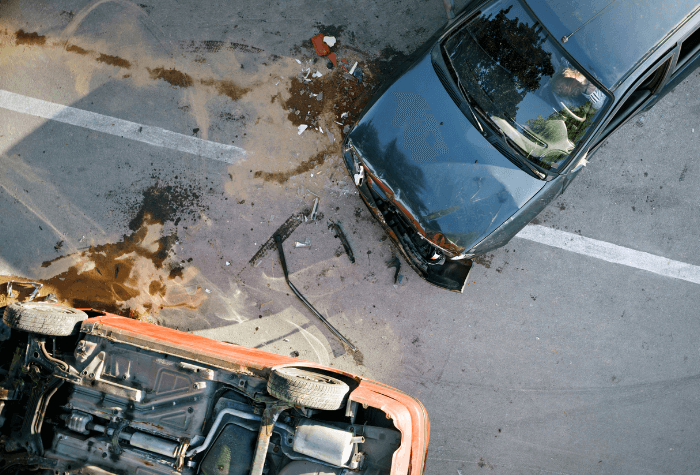
In most modern cars, occupants are comparatively well protected from side impacts (or T-bone accidents) from compact cars. People within the impacted car are more likely to sustain serious head and chest injuries if the impacting vehicle has a higher front configuration, like many SUVs or trucks, unless head-protecting side airbags are present.
Since T-bone incidents can be just as dangerous and devastating as head-on or rollover collisions, it’s crucial for car accident victims to work with a lawyer to handle their claims. It might be difficult to prove negligence, which is required to establish liability, especially when insurance companies and other attorneys are involved.
What is a T-Bone Accident?
Similar to a highway accident, in a side-impact crash, there is a higher likelihood of serious vehicle damage and occupant injuries. The location of the collision, the existence of safety systems, the speeds of both cars, as well as the weight and construction of the vehicles, all play a role in this.
If the car crash is severe, the struck automobile may spin out or roll over, causing it to strike other cars, objects, or people. Frequently, a T-bone accident collision will cause vehicle parts to interlock, making it impossible for the two involved cars to move.
Steps to Take After a T-Bone Accident
After any auto accident, safety is the number one priority. All parties involved in the wreck should move out of harm’s way and call the police and other emergency authorities. Once everyone has been deemed safe, it is important to remain at the scene.
Irrespective of who caused the T-bone accident, all persons involved should exchange information, including insurance and driver’s license details. Additionally, the parties should ask any witnesses to provide identification and statements. The sooner this information can be gathered after the car accident, the better.
All parties concerned should always give a truthful and consistent statement because the insurance company or companies will probably want to see them. The major objective of insurance adjusters is to try to get concessions or other proof to lessen their insured’s liability after the accident.
Gathering all evidence and keeping diligent records helps prove fault and also helps establish your claim for damages.
Proving Fault After a T-Bone Accident
Since it could be more challenging to determine who was at fault in a T-bone accident, it is crucial to leave the cars in their current locations until a police officer arrives and photos are taken. Car accident fault can also be determined by using other evidence from the accident site, such as skid marks, damage, debris, and physical injuries. It is crucial to gather all available evidence as soon as possible because it can fade away rapidly and/or witness testimony can be forgotten.
Obtaining all evidence in an efficient and quick manner is not only important to preserve the scene and determine fault but also to meet the state’s statute of limitations. In Texas, the statute of limitations for a vehicle accident (or any personal injury case) is two years. The clock starts running from the date of the accident for vehicle collision cases.
Determining fault is the most important element to establish negligence in a car accident case. Most auto accident cases are won by showing a party was acting in a negligent way while driving.
Establishing Negligence in a T-Bone Accident
Negligence in any personal injury case is always established by proving the following four elements:
- Duty: The at fault party owed a duty to the injured party
- Breach: The at fault party breached their duty
- Causation: The breach of the duty caused the injured party’s harm
- Damages: The victim suffered actual physical damages as a result
Duty is the easiest to prove because all drivers owe everyone on the road a duty of care when operating their vehicles. This means that they should not drive in a reckless manner and not engage in any distracting activities while driving.
A T-bone accident typically occurs when someone runs a stop sign or red light, which happens when someone is driving recklessly or using their cell phone while driving. This would be a breach of their duty of care. Once this breach is established, an experienced personal injury trial lawyer will then show that this breach was the cause of the car accident, which would establish fault or liability.
Finally, the party bringing a legal action against the other driver must show that they suffered some type of damages, including a medically documented physical injury.
Statistics for T-Bone Accidents
The most recent reported year saw 5,866 fatalities from single-passenger vehicle and multiple-passenger vehicle T-bone accident events, according to the Insurance Institute for Highway Safety (IIHS). A quarter of those fatal auto accidents were caused by T-bone crashes. Head-on collisions, which were responsible for nearly 54 percent of all fatal crashes, were the second-most deadly type of motor vehicle collision.
The passengers are more likely to suffer injuries, such as car accident head injuries, in a T-Bone accident than the driver. According to recent results from the IIHS, 62 percent of the 36,096 people killed in motor vehicle crashes were passengers, which is why many people ask, “What are my rights as a passenger in a car accident?”. Frontal collisions caused 15 driver fatalities per million registered passenger vehicles in multi-vehicle accidents. Five deaths per million were caused by numerous vehicle side impacts, compared to two deaths per million caused by multiple vehicle rear impacts.
Contacting Wolf Law PLLC
Proving fault and handling insurance companies will be an added stress after an auto accident. No one should have to handle this on their own. Hiring an experienced attorney to handle your case will allow you more time to recover after a T-bone accident.
Contact the personal injury attorneys at Wolf Law PLLC to guide you through the legal process and help you obtain favorable results, including the financial compensation you need and deserve.
